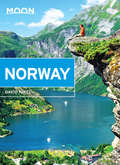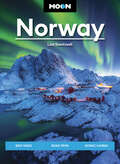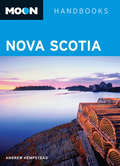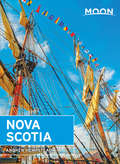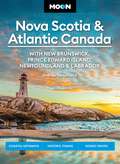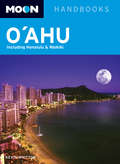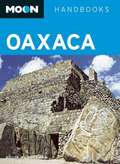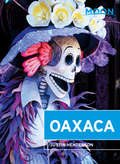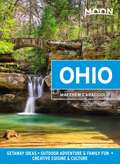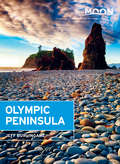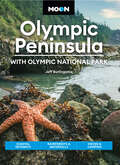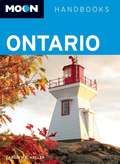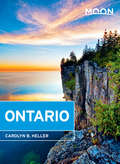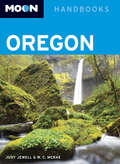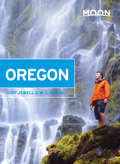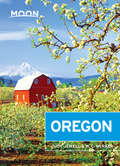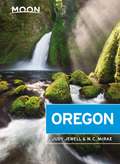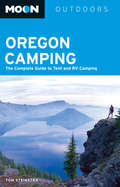- Table View
- List View
Moon Norway (Travel Guide)
by David NikelMoon Travel Guides: Your World Your WayExperience magnificent fjords, historical cities, and magical northern lights with Moon Norway.Inside you'll find:Flexible, strategic itineraries for every timeline and budget, from a week of the highlights to a three-week adventure through the whole countryFull-color photos and detailed maps throughoutCurated advice for outdoor adventurers, history buffs, culture mavens, road-trippers, and moreMust-see attractions and off-beat ideas for making the most of your trip: Find the best photo ops to capture Geirangerfjord's slender waterfalls, or hike to soaring cliffs overlooking glistening glacial lakes. Hope in the car and drive over islets and skerries on the Atlantic Road, or take a scenic train ride overlooking mountains, valleys, and fjords. Explore historic mountain towns, or wander small fishing villages along Norway's dramatic coastline. Admire world-class architecture and art in Oslo's cosmopolitan hub, or see the impressive restored vessels at the Viking Ship Museum. Sample fresh seafood and farm-to-table delicacies, mingle with the locals at neighborhood pubs, and find the best places to see the mystical aurora borealis dance across the skyExpert advice on when to go, what to pack, and where to stay, from Norwegian transplant-turned-local David NikelHandy tools including a glossary and a Norwegian phrasebookDetailed background information on the landscape, climate, wildlife, and cultureTravel tips for international visitors, getting around with children or as a senior, and suggestions for LGBTQ+ travelWith Moon Norway's expert tips, myriad activities, and local insight, you can plan your trip your way.Country-hopping through Europe? Try Moon Iceland, Moon Ireland, or Moon Rome, Florence & Venice.
Moon Norway: Best Hikes, Road Trips, Scenic Fjords (Travel Guide)
by Lisa StentvedtFrom majestic fjords and mountains to fairytale towns and picturesque harbors, Norway is one of a kind. Savor Scandinavian life like a local with Moon Norway. Inside you&’ll find:Flexible itineraries including a two week 'Best of Norway,' a long weekend in Oslo, a Lofoten road trip, and more Outdoor adventures: Tip-toe across the blue-tinted ice of a glacier, climb dramatic rock formations, and trek to Tromsø to learn more about the Sami, the Indigenous people of Scandinavia. Watch the Northern Lights dance across the sky, kayak the spectacular Western fjords, and spot wildlife from puffins to polar bears Must-see highlights and unique experiences: Explore an authentic Viking village, stroll and shop in sophisticated Oslo, and wander the cobblestone streets of Bergen&’s historic dock area. Road-trip the Lofoten Isles for unforgettable views at every turn, marvel at the elaborate architecture of stave churches, and feast on farm-to-table cuisine Honest insight from Norwegian writer Lisa Stentvedt on her beloved home country, with tips for traveling sustainably and avoiding crowdsDetailed maps and full-color, vibrant photos throughoutFocused coverage of Oslo, Bergen, Stavanger and Southern Norway, Ålesund, the Lofoten Isles, and more Thorough background information on the landscape, wildlife, history, government, and culture With Moon's practical advice and insider tips, you can experience the best of Norway. Seeing more of Scandinavia? Check out Moon Copenhagen & Beyond. About Moon Travel Guides: Moon was founded in 1973 to empower independent, active, and conscious travel. We prioritize local businesses, outdoor recreation, and traveling strategically and sustainably. Moon Travel Guides are written by local, expert authors with great stories to tell—and they can't wait to share their favorite places with you. For more inspiration, follow @moonguides on social media.
Moon Nova Scotia
by Andrew HempsteadThis work offers easy to use maps and detailed descriptions covering camping,olfing, hiking, world-class festivals, beaches, wineries and gardens. Novacotia is home to wild beaches, coastal scenery, one of the most beautifulcenic drives in the world, and a rich heritage and colorful culture thateave their mark on the memories of visitors. Andrew Hempstead helps you have truly personal experience in this gorgeous province. Suggested traveltrategies and lists of must-see sights provide you with real insights so youan decide where you should go, stay, and eat - without hassles or regrets. ndrew's travel strategies include: The Best of Nova Scotia in One Week, Theistory Lovers Tour, and Coastal Cruisin'. Andrew details where to hike, bike,hop, ski, fish, and more. This work is complete with maps, photographs,llustrations, and special emphasis on leading destinations.
Moon Nova Scotia
by Andrew HempsteadOutdoorsman Andrew Hempstead offers an inside glimpse of the best of Nova Scotia, from taking a tour of Alexander Keith's Brewery to witnessing the world's highest tides at the funnel-shaped Bay of Fundy. In addition to tips on where to stay, eat, and recreate, Hempstead also suggests itineraries-such as Coastal Cruising, Artists and Artisans, and Family Road Trip-to help travelers make the most of their trip. Complete with details on hiking through national parks, joining in the fun at a ceilidh, and getting up close and personal with the world's rarest whales, Moon Nova Scotia gives travelers the tools they need to create a more personal and memorable experience.This full-color guide includes vibrant photos and helpful maps.
Moon Nova Scotia & Atlantic Canada: Coastal Getaways, Historic Towns, Scenic Drives (Moon Canada Travel Guide)
by Andrew Hempstead Moon Travel GuidesCatch a glimpse of the world's rarest whales, hike through lush forests, or wander around quaint historic towns: the very best of the northeast is yours with Moon Nova Scotia & Atlantic Canada. Inside you'll find:Strategic, flexible itineraries including scenic drives, ocean excursions, and the best of the Maritimes Top experiences and activities: Take in stunning scenery while driving the Cabot Trail or the Irish Loop, visit an active archeological dig at the Colony of Avalon, or study artifacts from the Titanic at the Maritime Museum of the Atlantic. Savor local oysters at a waterfront restaurant, sample seasonal beers at North America's oldest operating brewery, and refuel with a hearty rappie pie after a day of touring Nova Scotia Best outdoor adventures: Bike through UNESCO-protected towns or cruise past massive icebergs. Cross-country ski and snowmobile in Sugarloaf Park or skate on frozen lakes near Halifax. Hike along rocky shoreline or through wildflower-filled river valleys. Kayak to a secluded island for a picnic lunch and camp out under the stars at oceanside parks Expert advice from Canadian author Andrew Hempstead on when to go, where to stay, and how to get around Full-color photos and detailed maps throughoutBackground information on the environment, culture, and history In-depth coverage of Nova Scotia, New Brunswick, Prince Edward Island, Newfoundland, and Labrador Get to know the best of Nova Scotia and Atlantic Canada with Moon's local insight and expert tips. Exploring more of Canada? Check out Moon Canadian Rockies or Moon Victoria & Vancouver Island.About Moon Travel Guides: Moon was founded in 1973 to empower independent, active, and conscious travel. We prioritize local businesses, outdoor recreation, and traveling strategically and sustainably. Moon Travel Guides are written by local, expert authors with great stories to tell—and they can't wait to share their favorite places with you. For more inspiration, follow @moonguides on social media.
Moon Nova Scotia, New Brunswick & Prince Edward Island: Nova Scotia, New Brunswick, Prince Edward Island, Newfoundland & Labrador (Travel Guide)
by Andrew HempsteadYour World Your Way Travel writer and Canadian Andrew Hempstead shares his expert perspective on Nova Scotia, New Brunswick, and Prince Edward Island, guiding you to a memorable and unique experience. Whether you're hoping to get up close and personal with the world's rarest whales or join in at a ceilidh, Moon Nova Scotia, New Brunswick & Prince Edward Island has activities for every traveler. With itineraries like "The Currents of History” and "Family Road Trip,” expertly crafted maps, gorgeous photos, and Hempstead's trustworthy advice, Moon Nova Scotia, New Brunswick & Prince Edward Island provides the tools for planning your perfect trip!Moon Nova Scotia, New Brunswick & Prince Edward Island covers can't-miss sights and the best destinations including: Halifax Fundy Coast Cape Breton Island Charlottetown and Queens County Prince County
Moon Nova Scotia, New Brunswick & Prince Edward Island: Nova Scotia, New Brunswick, Prince Edward Island, Newfoundland And Labrador (Travel Guide)
by Andrew HempsteadSpot moose and porcupines on a secluded hike, relax in a candy-colored fishing village, and immerse yourself in Canada's maritime history with Moon Nova Scotia, New Brunswick & Prince Edward Island. Inside you'll find:Flexible itineraries including a coastal road trip and a multi-week Nova Scotia adventure, designed for foodies, families, outdoor adventurers, history buffs, and moreTop experiences and activities: Take a scenic drive along the coast, tour North America's oldest working brewery, or stroll around the town that inspired Anne of Green Gables. Feast on fresh lobster, crab, and salmon or sample traditional Acadian rappie pie. Board and explore historic ships harbored at a UNESCO World Heritage Site or learn how to forge metal and spin cloth at the living history settlement of Kings Landing Best outdoor adventures: Keep an eye out for the world's rarest whales, kayak along the craggy coast, and take in a colorful sunset on a harbor cruise. Hike through wildflower-filled meadows or bright fall foliage, kayak the alongside the craggy coast, or bike the beach boardwalks. Walk between giant sea stacks during low tide and let the sound of waves lull you to sleep at an oceanfront campsite Strategic advice from Canadian Andrew Hempstead on when to go, where to stay, and how to get aroundFull-color photos and detailed maps throughoutBackground information on the environment, culture, and historyEssential tips for families with children, travelers with disabilities, and moreExperience the natural beauty and fascinating history of Nova Scotia, New Brunswick, and Prince Edward Island with Moon's expert tips and unique experiences.Expanding your trip? Try Moon Atlantic Canada or Moon Canadian Rockies. About Moon Travel Guides: Moon was founded in 1973 to empower independent, active, and conscious travel. We prioritize local businesses, outdoor recreation, and traveling strategically and sustainably. Moon Travel Guides are written by local, expert authors with great stories to tell—and they can't wait to share their favorite places with you.For more inspiration, follow @moonguides on social media.
Moon O'ahu
by Kevin WhittonO'ahu resident Kevin Whitton provides a fresh look at one of America's most beloved vacation spots in Moon O'ahu. Whitton knows the best way to experience the island, from taking surf lessons at Kuhio Beach to bird-watching in Kawainui Marsh. He includes trip ideas like Best of O'ahu in Seven Days, as well as helpful information on dining, transportation, and accommodations for a wide range of travel budgets. Complete with details on visiting Pearl Harbor and hiking to the top of the Koko Crater Railway Trail, Moon O'ahu gives travelers the tools they need to create a more personal and memorable experience.This ebook and its features are best experienced on iOS or Android devices and the Kindle Fire.
Moon Oaxaca
by Bruce WhippermanSeasoned travel writer Bruce Whipperman covers the best of Oaxaca, from bargaining at the Mercado Juárez to exploring the Castillo de Moctezuma Aztec pyramid. Whipperman offers up unique trip strategies, including Best Beaches and Local Festivals & Native Markets, as well as experienced advice on where to go and what to see. Complete with information on visiting craft villages near Ocotlan and enjoying the vistas and fresh seafood of Puerto Ángel,Moon Oaxacagives travelers the tools they need to create a more personal and memorable experience.
Moon Oaxaca
by Justin HendersonThis full-color guide includes vibrant photos and helpful maps.Traveler and author Justin Henderson covers the best of Oaxaca, from bargaining at the Mercado Juárez to exploring the Castillo de Moctezuma Aztec pyramid. Henderson offers up unique trip strategies, including Best Beaches and Local Festivals & Native Markets, as well as experienced advice on where to go and what to see. Complete with information on sampling mezcal, Oaxaca's native liquor, and enjoying the vistas and fresh seafood of Puerto Ángel, Moon Oaxaca gives travelers the tools they need to create a more personal and memorable experience.
Moon Oaxaca (Travel Guide)
by Cody CopelandWith rugged mountain ranges and stunning Pacific coastline, savory mole and smoky mezcal, Oaxaca is more than just a stop along the way: it's an adventure in itself. Stay a while with Moon Oaxaca. Inside you'll find:Strategic itineraries for backpackers, foodies, ecotourists, and more, whether you're spending ten days or just a weekend in Oaxaca The top activities and unique experiences: Spend a day strolling Oaxaca City's cobblestone streets and stopping in trendy cafes, mezcal shops, artisan cooperatives, and art galleries. Tour the Zapotec ruins of Monte Albán, trek the mountain paths of the Sierra Norte, or surf the world-class swells off Oaxaca's coast. Revel in the blur of parades, fireworks, and friendly locals inviting you to view their ofrendas (altars) during Oaxaca's legendary Day of the Dead celebrationThe best local flavors: Indulge in steamy pozole from a street stand, try traditional mole negro, or snack on fried grasshoppers. Visit a mezcal distillery to sample the smoky spirit and explore the fields of spiky agave, or satisfy your sweet tooth with a frothy espumaLocal insight: Mexico City writer and former Oaxaca dweller Cody Copeland shares what inspires him about the regionFull-color photos and detailed maps throughoutHelpful background on the landscape, culture, history, and environment, plus tips on health and safety, how to get around, and a handy Spanish phrasebookWith Moon's practical tips and local insight, you can experience the best of Oaxaca.Looking for más Mexico? Check out Moon Yucatán Peninsula, Moon San Miguel de Allende, or Moon Mexico City.
Moon Ohio: Getaway Ideas, Outdoor Adventure & Family Fun, Creative Cuisine & Culture (Travel Guide)
by Matthew CaraccioloFrom cities with old-world charm to endless family adventures in the great outdoors, experience the best of the Buckeye State with Moon Ohio. Inside you'll find:Strategic, flexible itineraries for thrill-seekers, outdoor adventurers, families, and more Unique experiences and fun highlights: Wander Columbus&’s trendy neighborhoods on foot or escape to quiet Amish Country. Feel a rush of adrenaline at the famous Cedar Point amusement park, hit the Rock and Roll Hall of Fame, or spend a day at the zoo with the whole family. Kick back at a brewery (or stay at the world&’s first craft beer hotel!) and chow down on authentic German food The best outdoor adventures: Hike to stunning waterfalls in Cuyahoga Valley National Park, explore hidden caves, or head to the Lake Erie Islands for a quintessential summer camping trip Expert advice from Columbus local Matthew Caracciolo on when to go, how to get around, and where to stay Helpful resources on Covid and traveling to Ohio Full-color photos and detailed maps throughoutThorough information on the landscape, climate, wildlife, and history With Moon's local insight and practical tips, you can experience the best of Ohio. Exploring more of the Midwest? Try Moon Michigan or Moon Wisconsin. About Moon Travel Guides: Moon was founded in 1973 to empower independent, active, and conscious travel. We prioritize local businesses, outdoor recreation, and traveling strategically and sustainably. Moon Travel Guides are written by local, expert authors with great stories to tell—and they can't wait to share their favorite places with you. For more inspiration, follow @moonguides on social media.
Moon Olympic Peninsula
by Jeff BurlingameAuthor and Washington native Jeff Burlingame knows the best ways to enjoy the Olympic Peninsula, from strolling through the subalpine meadows and temperate rain forests of Olympic National Park to soaking and swimming at Sol Duc Hot Springs. Burlingame offers unique strategies so travelers can organize their trips around specific time restrictions and interests, such as A Long Weekend, Seven Days of Highlights, and-for Stephenie Meyer fans-Three Days of Twilight. With details on touring small towns, exploring the coast, and getting lost in nature,Moon Olympic Peninsulagives travelers the tools they need to create a more personal and memorable experience.
Moon Olympic Peninsula
by Jeff BurlingameAuthor and Washington native Jeff Burlingame knows the best ways to enjoy the Olympic Peninsula, from strolling through the subalpine meadows and temperate rain forests of Olympic National Park to soaking and swimming at Sol Duc Hot Springs. Burlingame offers unique strategies so travelers can organize their trips around specific time restrictions and interests, such as A Long Weekend, Seven Days of Highlights, and-for Stephenie Meyer fans-Three Days of Twilight. With details on touring small towns, exploring the coast, and getting lost in nature, Moon Olympic Peninsula gives travelers the tools they need to create a more personal and memorable experience.
Moon Olympic Peninsula: Coastal Getaways, Rainforests & Waterfalls, Hiking & Camping (Travel Guide)
by Jeff BurlingameDiscover endlessly explorable terrain, miles of rugged coastline, and a diverse array of rainforests, lakes, waterfalls with Moon Olympic Peninsula. Inside you'll find:Flexible, strategic itineraries from a weekend in Olympic National Park to a week-long adventure on the peninsulaMust-sees and unique experiences: Hike through wild elk habitats, dig for clams in the wet coastal sand, and soak your tired muscles in the remote Olympic Hot Springs. Kayak beneath snow-topped mountain peaks, fish the abundant rivers, and indulge in local delicacies like Dungeness crab. Wander through the intoxicating Hoh Rain Forest, hike the many trails of Olympic National Park, camp beneath starry skies, or relax with a glass of local Washington wineLocal insight from Washington-born journalist Jeff Burlingame on when to go, where to stay, and what to bringPractical advice on how to get around the Olympic Peninsula, plus how to get there from nearby cities like Seattle and TacomaFull-color photos and detailed, easy-to-use maps throughoutThorough information, including background on the landscape, wildlife, climate, and local cultureWith Moon Olympic Peninsula's expert advice and local know-how, you can plan your trip your way.Staying in the great outdoors? Try Moon Pacific Northwest Camping, Moon Oregon Camping, or Moon Washington Camping. Exploring more of the Pacific Northwest? Try Moon Oregon, Moon Washington, or Moon Seattle.
Moon Olympic Peninsula: Coastal Getaways, Rainforests & Waterfalls, Hiking & Camping (Travel Guide)
by Jeff BurlingameCharming small towns, verdant rainforests, rocky coastline, and mountain meadows: experience the surreal beauty and endless adventure of the Pacific Northwest with Moon Olympic Peninsula. Inside you'll find:Flexible itineraries, from a weekend in Olympic National Park to a week-long tour of the peninsula, for outdoors enthusiasts, families with kids, and moreMust-see highlights and unique experiences: Tour the oldest lighthouse on the Puget Sound, explore Kurt Cobain's hometown, or immerse yourself in the region's rich maritime history. Dig for a dinner of fresh razor clams in the wet coastal sand and savor fresh-caught Dungeness crab. Stroll through a fragrant lavender farm, shop for handcrafted goods, or peruse small-town galleries for local art. Sample one-of-a-kind red blends and fruit wines or kick back with a local brew and some jazz musicThe best hikes of the Olympic Peninsula: Find your adventure with hike descriptions, directions, difficulty ratings, and elevation gainsOutdoor adventures: Wander through the ethereal Hoh Rain Forest, marvel at the panoramic views from Hurricane Ridge, or hike through the old-growth forests of Olympic National Park. Take a waterfall-filled backpacking trek through the Sawtooth Mountains, camp on the banks of the Skokomish River, and soak in the restorative waters of the Olympic Hot Springs. Spot hundreds of species of birds in the largest natural sand spit in the world or study starfish and sea stacks on the rugged northern coastLocal insight from Washington-born journalist Jeff Burlingame on when to go, where to stay, and what to bringFull-color photos and detailed maps throughoutHelpful background on the landscape, wildlife, climate, and local culture, plus tips on getting around the peninsulaWith Moon Olympic Peninsula's practical tips and expert advice, you can plan your trip your way. Want more of the great outdoors? Try Moon Pacific Northwest Hiking. Exploring the Pacific Northwest? Try Moon Pacific Northwest Road Trip, Moon Coastal Oregon, or Moon Seattle.
Moon Olympic Peninsula: Coastal Getaways, Rainforests & Waterfalls, Hiking & Camping (Travel Guide)
by Jeff Burlingame Moon Travel GuidesCharming small towns, verdant rainforests, rocky coastline, and mountain meadows: experience the surreal beauty and endless adventure of the Pacific Northwest with Moon Olympic Peninsula. Inside you'll find:Flexible itineraries, from a weekend in Olympic National Park to a weeklong tour of the peninsula Must-see highlights and unique experiences: Tour the oldest lighthouse on the Puget Sound, explore Kurt Cobain's hometown, or immerse yourself in the region's rich maritime history. Dig for a dinner of fresh razor clams and savor fresh-caught Dungeness crab. Stroll through a fragrant lavender farm, shop for unique handcrafted goods, or peruse small-town galleries for local art. Sample one-of-a-kind red blends and fruit wines or kick back with a local brew and some jazz music The best hikes of the Olympic Peninsula: Find your adventure with hike descriptions, directions, difficulty ratings, and elevation gains Outdoor adventures: Wander through the ethereal Hoh Rain Forest, marvel at the panoramic views from Hurricane Ridge, or hike through the old-growth forests of Olympic National Park. Take a waterfall-filled backpacking trek through the Sawtooth Mountains, camp on the banks of the Skokomish River, and soak in the restorative waters of the Olympic Hot Springs. Spot hundreds of species of birds on the largest natural sand spit in the world or study starfish and sea stacks on the rugged northern coast Local insight from Washington-born journalist Jeff Burlingame on when to go, where to stay, and what to bring Full-color photos and detailed maps throughoutHelpful background on the landscape, wildlife, climate, and local culture, plus tips for getting around the peninsula With Moon Olympic Peninsula's practical tips and expert advice, you can plan your trip your way. Want more of the great outdoors? Try Moon Washington Hiking. Exploring the Pacific Northwest? Try Moon Coastal Oregon or Moon Columbia River Gorge & Mount Hood.About Moon Travel Guides: Moon was founded in 1973 to empower independent, active, and conscious travel. We prioritize local businesses, outdoor recreation, and traveling strategically and sustainably. Moon Travel Guides are written by local, expert authors with great stories to tell—and they can't wait to share their favorite places with you. For more inspiration, follow @moonguides on social media.
Moon Ontario
by Carolyn B. HellerProfessional travel writer Carolyn Heller shares the best ways to experience all that Ontario has to offer, from scuba diving shipwrecks in the Great Lakes to dining on contemporary fare at Toronto's hottest restaurants. Heller leads readers to the highlights of this fascinating region with trip ideas such as Food and Wine Touring, Active Adventures, and History and Culture—providing different approaches for different kinds of travelers. Complete with tips on enjoying more than just the falls on the Niagara peninsula, hopping a ferry to Pelee Island for wine-tasting and relaxation, and ice skating on the world's longest skating rink in Ottawa,Moon Ontariogives travelers the tools they need to create a more personal and memorable experience.
Moon Ontario
by Carolyn HellerProfessional travel writer Carolyn B. Heller shares the best ways to experience all that Ontario has to offer, from scuba diving shipwrecks in the Great Lakes to dining on contemporary fare at Toronto's hottest restaurants. Heller leads readers to the highlights of this fascinating region with trip ideas such as Food and Wine Touring, Active Adventures, and History and Culture-providing different approaches for different kinds of travelers. Complete with tips on enjoying more than just the falls on the Niagara peninsula, hopping a ferry to Pelee Island for wine-tasting and relaxation, and ice skating on the world's longest skating rink in Ottawa, Moon Ontario gives travelers the tools they need to create a more personal and memorable experience.
Moon Oregon
by W. C. Mcrae Judy JewellOutdoors enthusiasts and Portland residents Judy Jewell and W. C. McRae cover the very best of the state inMoon Oregon. From the lush Lost Forest to Sparks Lake, Jewell and McRae offer their firsthand experience in unique trip strategies for a variety of travelers. Complete with expert tips on the best parks, bars, museums, and shopping areas,Moon Oregongives travelers the tools they need to create a more personal and memorable experience.
Moon Oregon
by W. C. Mcrae Judy JewellOutdoors enthusiasts and Portland residents Judy Jewell and W. C. McRae offer unique insight into Oregon's many offerings, from its lush forests and deep river canyons to its award-winning wines and friendly cities. Jewell and McRae include unique trip strategies that connect with travelers' specific interests, such Best Bike Rides, The Wine Route, and As Seen in Portlandia. With information on browsing through the Sisters Farmers' Market, attending Ashland's famous Oregon Shakespeare Festival, and kite-boarding near Hood River, Moon Oregon gives travelers the tools they need to create a more personal and memorable experience.
Moon Oregon
by W. C. Mcrae Judy JewellOutdoors enthusiasts and Portland residents Judy Jewell and W. C. McRae offer unique insight into Oregon's many offerings, from its lush forests and deep river canyons to its award-winning wines and friendly cities. Jewell and McRae include unique trip strategies that connect with travelers' specific interests, such Natural History Road Trip, Eastern Oregon Ramble, and The Wine Route-a seven-day tour of the state's numerous wineries. With information on browsing through the Sisters Farmers' Market, attending Ashland's famous Oregon Shakespeare Festival, and kite-boarding near Hood River, Moon Oregon gives travelers the tools they need to create a more personal and memorable experience.
Moon Oregon
by W. C. Mcrae Judy JewellJoin Oregon experts Judy Jewell and W. C. McRae for an unforgettable experience. With their unique perspective and advice you can trust, Moon Oregon has everything you need to know to have a more personal and memorable experience.Moon Oregon shows you what you need to know to plan the perfect trip for you. Whether you are looking to fill your adventure with night skiing, waterfall hikes, and sand-dune treks or experience a local's perspective on Portland's laid-back lifestyle, Moon Oregon has something for everyone. Along with trip ideas like "Day Trips from Portland" and "Touring the Taps", Jewell and McRae share their advice on local craft breweries, eclectic art shows, and the best places to bike, hike, and raft, as well as suggestions for wine-tasting in the beautiful Willamette Valley.With expertly crafted maps and gorgeous photos, this full-color guidebook gives you the tools you need to have an immersive and unique experience.Moon Oregon includes areas such as:PortlandColombia River Gorge and Mount HoodThe Willamette ValleyNorth CoastCentral CoastSouth CoastAshland and Southern OregonBend and Central OregonNortheastern OregonSoutheastern OregonFind the Moon guide that best suits your trip! Staying in the area? Check out Moon Coastal Oregon and Moon Washington.
Moon Oregon (Travel Guide)
by Judy Jewell W. C. McRaeDiscover Oregon with Moon Travel Guides!The jagged coastline, quirky towns, and stunning breadth of nature: Oregon is like a living postcard. Dig into this unique state with Moon Oregon.Strategic itineraries that can adapted for your timeline and budget, whether you're wine tasting for a weekend, spending a few days in Portland, or road tripping the whole state Curated advice for outdoor adventurers, foodies, culture and history buffs, and moreCan't-miss experiences and unique activities: Sample oysters in quaint seaside towns on a coastal road trip, or get to know Portland's renowned craft beer scene. Hike to rushing waterfalls, soak in hidden hot springs, and spot wild mustangs, gray whales, or eagles. Trek to unbeatable views of Crater Lake, the deepest lake in America, cycle the banks of the Willamette River, or ski the fresh powder on Mount Hood. Catch a performance at the Shakespeare Festival in Ashland, shop for organic produce at a local farmers market, or sip your way through Oregon's best wineriesExpert insight from Oregon locals Judy Jewell and Bill McRaeHonest advice on when to go, how to get around, and where to stay, from Full-color photos and detailed maps throughout Focused coverage of Portland, Columbia River Gorge and Mount Hood, the Willamette Valley, the North, Central, and South Coasts, Ashland and Southern Oregon, Bend and Central Oregon, and Northeastern and Southeastern OregonThorough background information on the culture, landscape, climate, and wildlife, plus handy recommendations for international visitors, traveling with kids, LGBTQ+ travelers, and travelers with disabilitiesWith Moon Oregon's practical tips, myriad activities, and local know-how, you can plan your trip your way.Spending more time in the Beaver State? Try Moon Portland or Moon Coastal Oregon. Hitting the road? Try Moon Pacific Northwest Road Trip.
Moon Oregon Camping
by Tom StienstraTop-selling outdoors writer Tom Stienstra covers the adventures of camping in Oregon, including notable campsites along the Oregon Coast, Portland and the Willamette Valley, the Columbia River Gorge and Mount Hood, as well as the Southern Cascades. Stienstra provides easy-to-follow maps with driving directions to each campground, along with camping options from secluded alpine hike-ins to convenient roadside stopovers. Complete with details on what to pack, what to wear, reservations, fees, and the best camping facilities, Moon Oregon Camping gives travelers the tools they need to create a more personal and memorable camping experience.
